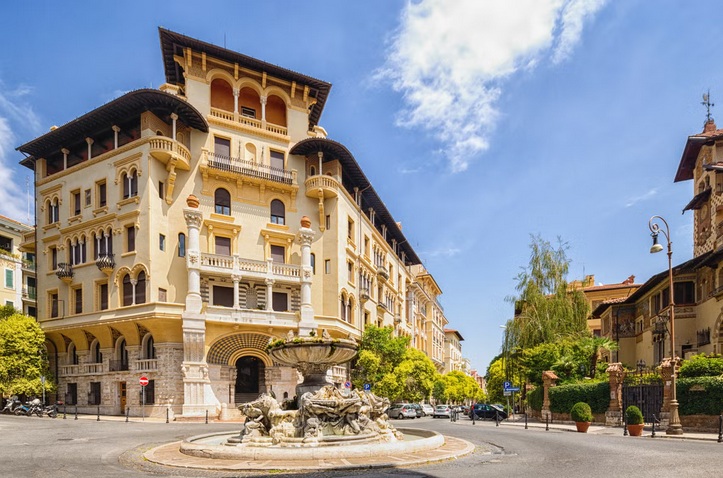cctm collettivo culturale tuttomondo Gino Coppedè (Italia)

foto: quartiere Coppedè, Coppedè quarter, Roma
A pochi passi dalla trafficata arteria suburbana di Viale Regina Margherita, lontano dalle principali attrazioni turistiche di Roma, tra Corso Trieste e Parioli, si trova l’insolito quanto affascinante quartiere Coppedè.
Il Quartiere Coppedè è un crocevia di quattro isolati, caratterizzati da un fantastico mix di greco antico, barocco romano, manierista, medievale e soprattutto Art Nouveau. Lo stile unico ed eclettico del quartiere si deve all’architetto fiorentino Gino Coppedè, da cui il quartiere stesso prende il nome.
Just a stone’s throw from the busy suburban avenue of Viale Regina Margherita, far from Rome’s main tourist routes, between Corso Trieste and Parioli, lies the unusual yet enchanting Coppedè district.
The Coppedè Quarter is made up of four blocks, a true crossroads of styles where Ancient Greek, Roman Baroque, Mannerist, Medieval, and above all Art Nouveau blend together in a striking mix. This unique and eclectic neighborhood is the work of the Florentine architect Gino Coppedè, whose name it still bears today.
Gino Coppedè (Firenze, 1866 – Roma, 1927), è stato un architetto, scultore e decoratore italiano, esponente dello stile Liberty (Art Nouveau).
Studiò presso le Scuole Pie e la Scuola Professionale di Arti Decorative Industriali a Firenze, conseguendo un diploma che gli permise di lavorare come architetto, e successivamente si diplomò anche presso l’Accademia delle Belle Arti di Firenze come professore di disegno architettonico.
Coppedè iniziò la sua carriera lavorando nel laboratorio di suo padre da dove maturò una profonda conoscenza dell’arte dell’intaglio e dell’ornamentazione. Si trasferì poi a Genova, dove ottenne i primi importanti incarichi, tra cui il celebre Castello Mackenzie, uno dei suoi maggiori successi. La sua opera si caratterizza per uno stile eclettico e altamente decorativo, che reinterpreta elementi del Rinascimento e del Manierismo con un tocco quasi fiabesco e misterioso.
Tra le sue opere più notevoli c’è il “Quartiere Coppedè” a Roma, un complesso residenziale unico per la sua atmosfera magica e fantasiosa, con una ricca ornamentazione e dettagli architettonici simbolici. Nel corso della sua carriera lavorò anche su progetti come il Palazzo Galli a Napoli, la Villa Barsanti a Pietrasanta, il castello Villa La Gaeta sul Lago di Como e il progetto per la stazione di Roma Termini.
Fu docente universitario, accademico e ricevette onorificenze per il suo contributo all’arte e all’architettura.
Gino Coppedè (Florence, 1866 – Rome, 1927) was not only an architect, but also a sculptor and decorator, and one of the leading figures of Italy’s Liberty style—the local expression of Art Nouveau.
He studied at the Scuole Pie and the School of Decorative Industrial Arts in Florence, later graduating from the Academy of Fine Arts as a professor of architectural drawing. He first trained in his father’s workshop, where he developed a strong passion for carving and ornamentation, before moving to Genoa. There he landed his first major commissions, including the famous Mackenzie Castle, one of his greatest masterpieces. His style soon became known for its eclectic, richly decorative character, reimagining Renaissance and Mannerist traditions with a touch of mystery and fairytale charm.
Among his most extraordinary creations is Rome’s “Quartiere Coppedè,” a residential complex unlike any other, with its magical, dreamlike atmosphere, lavish details, and symbolic motifs hidden in the architecture. Throughout his career, Coppedè also designed works such as Palazzo Galli in Naples, Villa Barsanti in Pietrasanta, Villa La Gaeta on Lake Como, and even a project for Rome’s Termini Station.
Respected as a professor and academic, he was also honored for his lasting contributions to Italian art and architecture.
_
cctm Roma quartiere Coppedè
